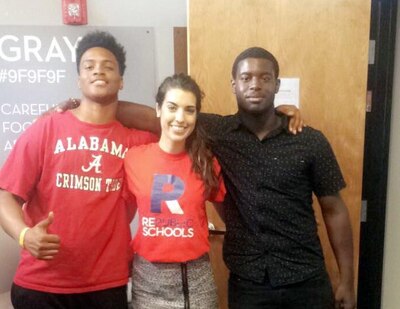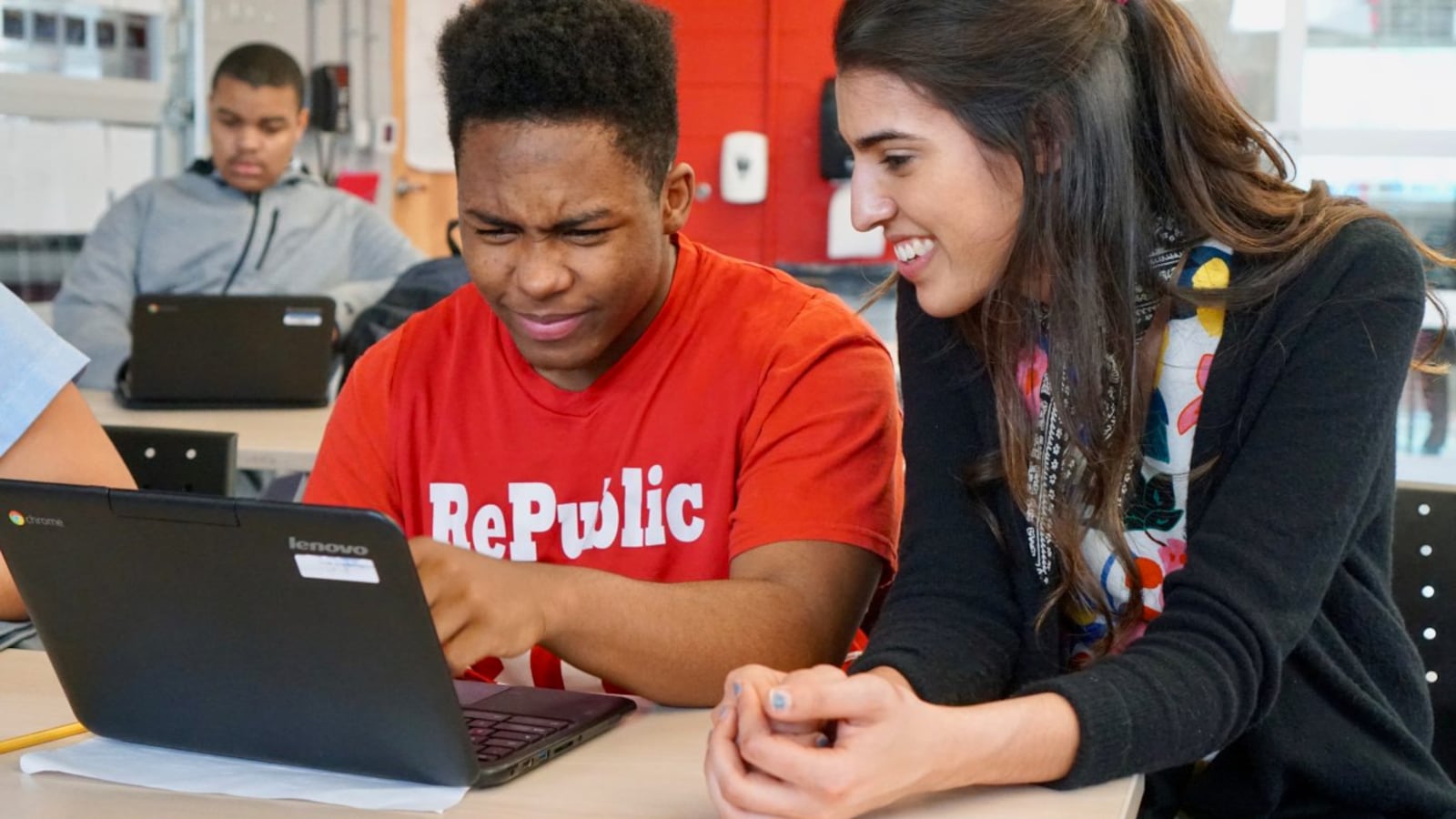How do teachers captivate their students? Here, in a feature we call How I Teach, we ask great educators how they approach their jobs. You can see other pieces in this series here.
Mehreen Butt has helped to build an award-winning computer science program at a Nashville charter school – and she’s doing it in part for other young women of color like her.
The educator for RePublic High School said her goal is to close the gaps in computer science for women and people of color.
Ninth graders at the charter school start with Intro to Advanced Placement Computer Science with another teacher, Namita Manohar, before moving to AP Computer Science Principles in the 10th grade with Butt or a fellow teacher. Butt and Manohar worked together to build out the program.
Butt said her students won six awards from the National Center for Women & Information Technology this year and have been state finalists for the Samsung Solve For Tomorrow Challenge.
“Research has shown that girls are more likely to persist in computer science when they have a teacher or mentor personally express his or her belief in their abilities,” Butt said. “This has stuck with me over the years, and I consistently remind myself to prioritize that approach.”
We spoke with Butt about how she came to love computer science, why she wants to see more women of color in science or math fields, and what helps women persist and lead in those careers. Her answers have been lightly condensed for clarity.
What drew you to teaching computer science/coding?
Computer science is driving innovation across every industry and automating a lot of jobs through technology and machine-learning. So I think from a practical sense, I first became interested in coding to keep up with current trends in technology and diversify my own skill set as a professional.
But the reason that I love computer science is that it is all about creativity and bringing an idea or vision to life through problem-solving. I want my students to recognize that they don’t have to just be a programmer to use coding. Instead, they can leverage technology for their own interests — whether it be in medicine, business, or fashion.
How do you get to know your students?
Since AP Computer Science is such a rigorous course, I have students who stay after school a lot for tutoring. I use these opportunities as a way to grow positive relationships and learn more about my students’ interests and life outside of school. I also typically notice that kids who may have struggled at first tend to become more invested after attending tutoring.
Sitting in the student section at school sporting events is also my other favorite way to get to know students better!
Tell us more about the computer science program you have helped build. What are the most important elements of the program? What do you most want your students to walk away with?
Our students begin learning to code in the fifth grade. Throughout middle school and high school, they learn the foundations of HTML, CSS, JavaScript, and computational thinking — all skills and experiences to prepare for the AP Computer Science Principles course and potentially a future career as a developer if they choose.
We are also creating partnerships with our school and the local entrepreneurship and tech community in Nashville. Recently, we took a group to the Twende event at the Nashville Entrepreneur Center, where our students networked with Black and Brown startup founders and innovators from our community. We are committed to providing access for our students through STEM summer programs and internships. We have spent a significant amount of time identifying programs and coaching students on how to submit strong applications. The reality is that it’s hard to compete for opportunities that you don’t know about.
The most important part of our computer science program is opportunity and access. I want students to have a positive STEM experience and remember what it feels like to be confident and resilient in a science classroom. I know what it’s like to sit in a room with your peers and feel “outsmarted” or self-conscious because you were uncertain about getting the right answer. I also know that those feelings often are augmented when entering a STEM career — especially for women of color where we often feel outnumbered by our male peers. It is important that my students end the school year with increased confidence in their abilities, pride in a completed project, and a support system of teacher mentors should they pursue a career in STEM.
How do you think about your role in the classroom, in particular, as a woman of color teaching about a field that is predominately male and white?
For girls, opportunity and access are merely a starting point to increasing the diversity of the tech workforce. Persistence in the field requires support, mentorship, and thoughtful development of leadership pathways for women. Even with the pioneering work that several organizations have done in the field, women – especially women of color – do not persist at the same rate as men.
It is exciting to see students who might not otherwise enroll in an AP course feel confident and successful in a college-level class as a 10th grader. Research has shown that girls are more likely to persist in computer science when they have a teacher or mentor personally express his or her belief in their abilities. This has stuck with me over the years, and I consistently remind myself to prioritize that approach – both in the classroom and when attracting students to apply for outside computer science opportunities. In particular, I think of two of our rising female seniors who are participating in collegiate research at Vanderbilt under the mentorship of female Ph.D. candidates and will present a final symposium project at the end of the summer.
Why is it important to see more women of color go into science and math careers?
When we look at a middle school classroom [in math and science], we see girls performing at the same level (if not better) as the boys. Sometime during high school, this interest drops off. When girls continue to fall out of upper-level science and math classes at a much higher rate than boys – which is even more pronounced for students of color – this inequity persists.
Computer science is changing how we solve problems. However, without the lived experiences of female voices in the field, and especially those of women of color, we are missing out on opportunities to create inclusive technology applications derived from diverse perspectives and approaches. By exposing more girls to computer science, we accelerate the number and quality of creative solutions to pressing social challenges.
What object would you be helpless without during the school day?
My watch! It’s really easy to lose track of time when working on class projects – especially code that needs to be debugged!
What’s something happening in the community that affects what goes on inside your class?
I think that we’ve seen a lot of effort put into building curricula and student interest around what it’s like to work at a startup in Silicon Valley.

But our kids are also interested in activism, social justice, and creating positive change. I encourage students to incorporate issues that they are passionate about into our projects. For example, many of our students and their families are affected by changes in immigration policy.
Last year, we had an all-girls team develop a prototype and business that better supported immigrants in navigating the U.S. healthcare system. What started as a problem in our school community eventually led the girls to win a local pitch competition and being a Tennessee state finalist in the 2018 -2019 Samsung Solve For Tomorrow competition. I think it’s important that students see how computer science and technology can be used to drive collective change, especially at the local level.
What part of your job is most difficult?
When I think about my responsibility as an AP teacher and fulfilling the promises that we have made to our RePublic families, I always carry the weight of each student’s results. AP scores can often be a “numbers” game. For many of our students though, the AP Computer Science course is generally their first opportunity to earn college credit — and perhaps even the first in their own family.
In the past, I had a hard time looking at scores that didn’t reflect who my students were, their experiences, or the content they knew. Over the past three years, I’ve used these stories, both successes and failures, to help build a better program.
What was your biggest misconception that you initially brought to teaching?
My biggest misconception that I brought to teaching AP Computer Science was that I thought that every student would love the content as much as I did. Over the past couple of years, I have spent a lot more time thinking about how to spark curiosity and make connections with students’ own personal interests to engage them more in what we’re learning. Computer science is extremely applicable to our lives today, but I’ve learned to be more intentional about addressing the ways in which our students experience technology both in and out of the classroom.
What are you reading for enjoyment?
I’m really into ThePLUG as of late. It’s the first daily tech newsletter for Black founders and innovators. There are many stories that I have used as the framework for a lesson in my classroom. It’s also a great way for teachers to stay in touch with what’s going on in the tech and entrepreneurship industry.


